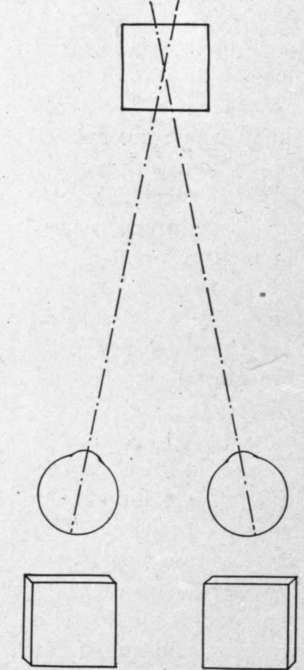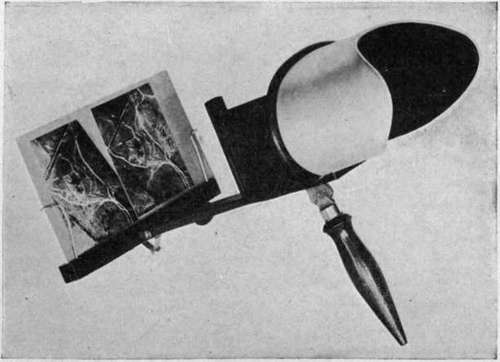Principles Of Stereoscopic Vision
Description
This section is from the book "Airplane Photography", by Herbert E. Ives. Also available from Amazon: Airplane photography.
Principles Of Stereoscopic Vision
The ability to see objects in relief is confined solely to man and to a few of the higher animals in whom the eyes are placed side by side. When the eyes are so placed they both see, to a large extent, the same objects in their fields of view. Owing to the separation of the eyes the actual appearance of all objects not too far away is different, and it is by the interpretation of these differences that the brain gets the sensation of relief. Thus in Fig. 149 the two eyes are shown diagrammatically as looking at a cube. The right eye sees around on the right-hand face of the cube, the left eye on the left-hand face of the cube. The two aspects which are fused and interpreted by the brain are shown in the lower diagram.
Stereoscopic views or stereograms, made either by photography or, in the early days, by careful drawing, consist of pairs of pictures made of the same object from two different points. For ordinary stereoscopic work these points are separated by the distance between the eyes, approximately 65 millimeters or 2% inches. These two pictures are then so viewed that each eye receives its appropriate image from the proper direction, whereupon the object delineated stands out in relief. Fusion of the two elements of the stereoscopic picture can take place without the assistance of any instrument, if the eyes are properly directed and focussed, but this comes only with practice. Holding the stereogram well away from the face the eyes are directed to a distant object above and beyond, in order to diverge the axes. Then without converging, the eyes are dropped to the picture, which should spring into relief. It is necessary in moving the eyes from the distant object to the near stereogram to alter their focus somewhat, depending on how near the stereogram is held; and the success of the attempt to fuse the images depends on the observer's ability to maintain the eyes diverged for a distant object while focussing for a near one. Near-sighted people (ontakingoff their glasses) fuse the stereoscopic images quite easily, since their eyes do not focus on distant objects even when diverged for them. Transparencies are easier to fuse than paper prints, but in any case where a stereoscope is not used the separation of image centers should not be more than that of the eyes, which pass through the centers of the two pictures to a point in space in front of the observer. The two lenses should be mounted so as to provide for the adjustment of their separation to fit different eyes and print spacings. The most common form of stereoscope is that designed by Holmes, for viewing paper print stereograms (Fig. 150). It has prismatic lenses of an appropriate angle to converge pictures whose centers are three inches apart, instead of the lesser distance appropriate to stereograms intended for fusing.

Fig. 149. - The principle of stereoscopic vision.

Fig. 150. - Common form of prism stereoscope.
Continue to:
Tags
camera, lens, airplane, aerial, film, exposure, photography, maps, birdseye
